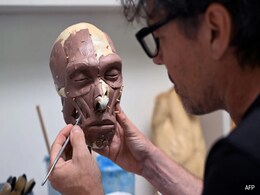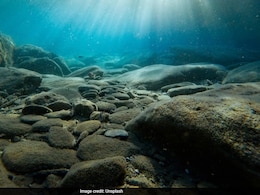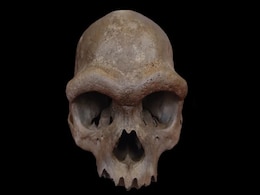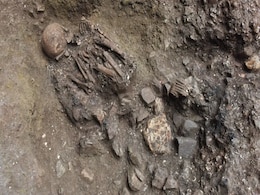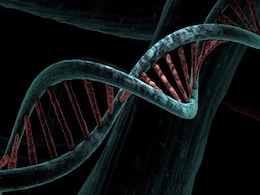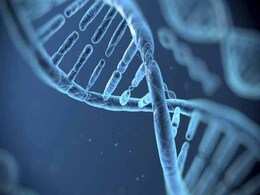Dna Evolution
- All
- News
-

Scientists Reconstruct Bust Of Woman From 10,500 Years Ago
- Thursday July 31, 2025
- World News | Agence France-Presse
Reborn via a close partnership between science and art, Mos'anne's bust was created at Belgium's Ghent University as part of a project to explore how the region's last hunter-gatherers lived during the Mesolithic era.
-
 www.ndtv.com
www.ndtv.com
-

5 Arms, No Eyes, No Heart: DNA Revealed Weird Deep-Sea Brittle Star Journey
- Thursday July 24, 2025
- World News | Tim O'Hara, The Conversation
You may have read that the deep sea is a very different environment from the land and shallow water. There is no light, it is very cold, and the pressure of all the water above is immense.
-
 www.ndtv.com
www.ndtv.com
-

China’s Dragon Man Skull Found to Belong to Denisovan Lineage
- Saturday June 21, 2025
- Written by Gadgets 360 Staff
A 146,000-year-old skull discovered in Harbin, China, has been confirmed as Denisovan using ancient DNA and protein analysis. Named “Dragon Man,” the fossil is the most complete Denisovan specimen to date, offering a new understanding of human evolution and Denisovan presence across Ice Age Asia.
-
 www.gadgets360.com
www.gadgets360.com
-

7,100-Year-Old Skeleton Reveals Unknown Human Lineage in China
- Saturday May 31, 2025
- Written by Gadgets 360 Staff
A groundbreaking study of a 7,100-year-old skeleton found in Yunnan, China, has revealed a "ghost" human lineage previously known only through genetic inference. The woman, named Xingyi_EN, belonged to a deeply divergent group called the Basal Asian Xingyi lineage, which may have contributed to modern Tibetan ancestry. This discovery, along with ev...
-
 www.gadgets360.com
www.gadgets360.com
-

1 Trillion Species, 3 Billion Years: AI Helped Trace Bacteria Evolution On Earth
- Friday April 4, 2025
- World News | The Conversation
Bacteria consist of a single cell. They do not have bones and are not like big animals that leave clear signs in the geological record, which thankful palaeontologists can study many millions of years later.
-
 www.ndtv.com
www.ndtv.com
-

Ancient Europeans Retained Dark Skin, Hair and Eyes Until the Iron Age, Claims New Study
- Monday March 17, 2025
- Written by Gadgets 360 Staff
A genetic study analysing 348 ancient DNA samples reveals that most prehistoric Europeans had dark skin, hair, and eyes well into the Iron Age. Although genes for lighter pigmentation appeared around 14,000 years ago, they remained rare until about 3,000 years ago. Lighter skin may have been advantageous for vitamin D production, while lighter eyes...
-
 www.gadgets360.com
www.gadgets360.com
-

Ancient DNA Study Shows How Early Europeans Adapted Over 7,000 Years
- Wednesday November 20, 2024
- Written by Gadgets 360 Staff
A study using ancient DNA has revealed how early Europeans adapted to their environments over 7,000 years. By examining genetic samples from archaeological remains, researchers found evidence of natural selection in traits like vitamin D production and lactose tolerance. Immune gene adaptations were also linked to agricultural shifts and disease ex...
-
 www.gadgets360.com
www.gadgets360.com
-

Scientists Unravel Rose Genetics: How Eastern and Western Species Created Modern Varieties
- Friday October 25, 2024
- Written by Gadgets 360 Staff
A recent study uncovers the genetic origins of modern roses, showing how Eastern and Western species combined to create the roses we know today. Led by Professor Zhangjun Fei at the Boyce Thompson Institute, researchers mapped the genome of the modern rose variety ‘Samantha®’ and sequenced 233 other rose varieties. The study sheds light on bre...
-
 www.gadgets360.com
www.gadgets360.com
-

Ancient DNA Reveals a Distinct Neanderthal Lineage That Evolved Separately for Over 50,000 Years
- Friday September 13, 2024
- Written by Gadgets 360 Staff
A recent discovery of Neanderthal DNA from a fossil named Thorin has revealed a previously unknown evolutionary path. Thorin’s lineage reportedly remained isolated from other Neanderthal populations for nearly 50,000 years. The DNA evidence suggests that this group evolved separately in Europe without intermingling with other Neanderthals or earl...
-
 www.gadgets360.com
www.gadgets360.com
-

New Study Reveals How Much Neanderthal DNA Still Exists In Modern Humans
- Friday June 9, 2023
- Science | Asian News International
Recent scientific findings have revealed that Neanderthal genes compose 1 to 4 per cent of the genome of modern-day humans whose ancestors moved out of Africa.
-
 www.ndtv.com
www.ndtv.com
-

Study Tracks 155 New Genes, Claims Humans Are Still Evolving
- Friday December 23, 2022
- Feature | Edited by Amit Chaturvedi
The scientists found that some of the newly-discovered genes can be tracked all the way back to the earliest days of mammals.
-
 www.ndtv.com
www.ndtv.com
-

When DNA Speaks of Nature — the Use of Genetic Data in Biodiversity Research
- Thursday May 13, 2021
- Bharti D. K. and Jahnavi Joshi
Understand the record of history stored in DNA is an essential part of a biologist's toolkit, and allows us to understand the tree of life — the origin of species, and the way it all works together. How have scientists come to understand this subject? We take a deeper dive.
-
 www.gadgets360.com
www.gadgets360.com
-

600 Million Years Ago, A Single Biological Mistake Changed Everything.
- Monday January 11, 2016
- World News | Sarah Kaplan, The Washington Post
If life is effectively an endless series of photocopies, as DNA is transcribed and passed on from one being to the next, then evolution is the high-stakes game of waiting for the copier to get it wrong.
-
 www.ndtv.com
www.ndtv.com
-

Scientists Reconstruct Bust Of Woman From 10,500 Years Ago
- Thursday July 31, 2025
- World News | Agence France-Presse
Reborn via a close partnership between science and art, Mos'anne's bust was created at Belgium's Ghent University as part of a project to explore how the region's last hunter-gatherers lived during the Mesolithic era.
-
 www.ndtv.com
www.ndtv.com
-

5 Arms, No Eyes, No Heart: DNA Revealed Weird Deep-Sea Brittle Star Journey
- Thursday July 24, 2025
- World News | Tim O'Hara, The Conversation
You may have read that the deep sea is a very different environment from the land and shallow water. There is no light, it is very cold, and the pressure of all the water above is immense.
-
 www.ndtv.com
www.ndtv.com
-

China’s Dragon Man Skull Found to Belong to Denisovan Lineage
- Saturday June 21, 2025
- Written by Gadgets 360 Staff
A 146,000-year-old skull discovered in Harbin, China, has been confirmed as Denisovan using ancient DNA and protein analysis. Named “Dragon Man,” the fossil is the most complete Denisovan specimen to date, offering a new understanding of human evolution and Denisovan presence across Ice Age Asia.
-
 www.gadgets360.com
www.gadgets360.com
-

7,100-Year-Old Skeleton Reveals Unknown Human Lineage in China
- Saturday May 31, 2025
- Written by Gadgets 360 Staff
A groundbreaking study of a 7,100-year-old skeleton found in Yunnan, China, has revealed a "ghost" human lineage previously known only through genetic inference. The woman, named Xingyi_EN, belonged to a deeply divergent group called the Basal Asian Xingyi lineage, which may have contributed to modern Tibetan ancestry. This discovery, along with ev...
-
 www.gadgets360.com
www.gadgets360.com
-

1 Trillion Species, 3 Billion Years: AI Helped Trace Bacteria Evolution On Earth
- Friday April 4, 2025
- World News | The Conversation
Bacteria consist of a single cell. They do not have bones and are not like big animals that leave clear signs in the geological record, which thankful palaeontologists can study many millions of years later.
-
 www.ndtv.com
www.ndtv.com
-

Ancient Europeans Retained Dark Skin, Hair and Eyes Until the Iron Age, Claims New Study
- Monday March 17, 2025
- Written by Gadgets 360 Staff
A genetic study analysing 348 ancient DNA samples reveals that most prehistoric Europeans had dark skin, hair, and eyes well into the Iron Age. Although genes for lighter pigmentation appeared around 14,000 years ago, they remained rare until about 3,000 years ago. Lighter skin may have been advantageous for vitamin D production, while lighter eyes...
-
 www.gadgets360.com
www.gadgets360.com
-

Ancient DNA Study Shows How Early Europeans Adapted Over 7,000 Years
- Wednesday November 20, 2024
- Written by Gadgets 360 Staff
A study using ancient DNA has revealed how early Europeans adapted to their environments over 7,000 years. By examining genetic samples from archaeological remains, researchers found evidence of natural selection in traits like vitamin D production and lactose tolerance. Immune gene adaptations were also linked to agricultural shifts and disease ex...
-
 www.gadgets360.com
www.gadgets360.com
-

Scientists Unravel Rose Genetics: How Eastern and Western Species Created Modern Varieties
- Friday October 25, 2024
- Written by Gadgets 360 Staff
A recent study uncovers the genetic origins of modern roses, showing how Eastern and Western species combined to create the roses we know today. Led by Professor Zhangjun Fei at the Boyce Thompson Institute, researchers mapped the genome of the modern rose variety ‘Samantha®’ and sequenced 233 other rose varieties. The study sheds light on bre...
-
 www.gadgets360.com
www.gadgets360.com
-

Ancient DNA Reveals a Distinct Neanderthal Lineage That Evolved Separately for Over 50,000 Years
- Friday September 13, 2024
- Written by Gadgets 360 Staff
A recent discovery of Neanderthal DNA from a fossil named Thorin has revealed a previously unknown evolutionary path. Thorin’s lineage reportedly remained isolated from other Neanderthal populations for nearly 50,000 years. The DNA evidence suggests that this group evolved separately in Europe without intermingling with other Neanderthals or earl...
-
 www.gadgets360.com
www.gadgets360.com
-

New Study Reveals How Much Neanderthal DNA Still Exists In Modern Humans
- Friday June 9, 2023
- Science | Asian News International
Recent scientific findings have revealed that Neanderthal genes compose 1 to 4 per cent of the genome of modern-day humans whose ancestors moved out of Africa.
-
 www.ndtv.com
www.ndtv.com
-

Study Tracks 155 New Genes, Claims Humans Are Still Evolving
- Friday December 23, 2022
- Feature | Edited by Amit Chaturvedi
The scientists found that some of the newly-discovered genes can be tracked all the way back to the earliest days of mammals.
-
 www.ndtv.com
www.ndtv.com
-

When DNA Speaks of Nature — the Use of Genetic Data in Biodiversity Research
- Thursday May 13, 2021
- Bharti D. K. and Jahnavi Joshi
Understand the record of history stored in DNA is an essential part of a biologist's toolkit, and allows us to understand the tree of life — the origin of species, and the way it all works together. How have scientists come to understand this subject? We take a deeper dive.
-
 www.gadgets360.com
www.gadgets360.com
-

600 Million Years Ago, A Single Biological Mistake Changed Everything.
- Monday January 11, 2016
- World News | Sarah Kaplan, The Washington Post
If life is effectively an endless series of photocopies, as DNA is transcribed and passed on from one being to the next, then evolution is the high-stakes game of waiting for the copier to get it wrong.
-
 www.ndtv.com
www.ndtv.com

